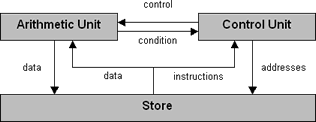
Digital & Embedded Systems
Tutorial 2: Central Processing Unit (CPU) Design
Introduction
This tutorial will show how to design a basic central processing unit (CPU). To simulate the operation of the CPU, the progam ReTrO will be used.
Von Neumann Architecture
The von Neumann architecture, named after its creator John von Neumann, is the basic model for a programmable, digital computer. Since its creation in 1945, this model has remained relatively stable and is still the basis for many microprocessors and microcontrollers.
von Neumann computer architecture
The two fundamental ideas put forth by von Neumann were
- The selection of the next instruction may depend on a result computed by the arithmetic unit.
- Data store and instruction store are the same.
These two innovations transformed computing machines from inflexible state machines, which could only follow one predetermined program execution, to flexible computers whose current state and inputs control the program flow. With a von Neumann computer, it is possible to create a program (i.e. an infinite loop) which would be impossible to run on earlier architectures such as the Babbage Analytical Engine.
